The History of Archery Targets Used in Brave
The Pixar movie Brave is a fun movie with some great archery scenes inspired by real archery technique and actual historical archery equipment. So this is a look back at the history of target archery, and archery targets, to see where the inspiration for some of the details in the movie came from.
Here is the archery contest from Brave:
In the contest they use cloth archery target faces with concentric circular rings fastened to coiled straw matts on portable easels.
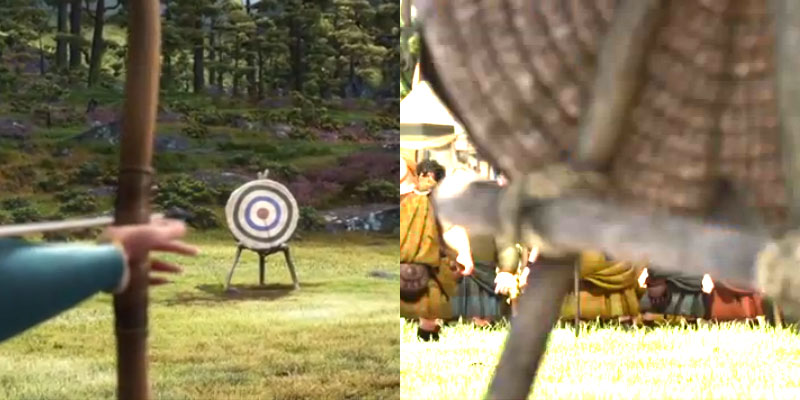
Front and back of a coiled straw archery target on an easel with a concentric ring cloth target face–from the archery contest scene in Brave .
That is a real type of archery target, common from the 1700’s up until a few decades ago.

Hertfordshire Archery Society at a coiled straw archery target. Note that there is no concentric ring target face. Instead is only a center mark. From The Ladies’ Pocket-Book, 1791.
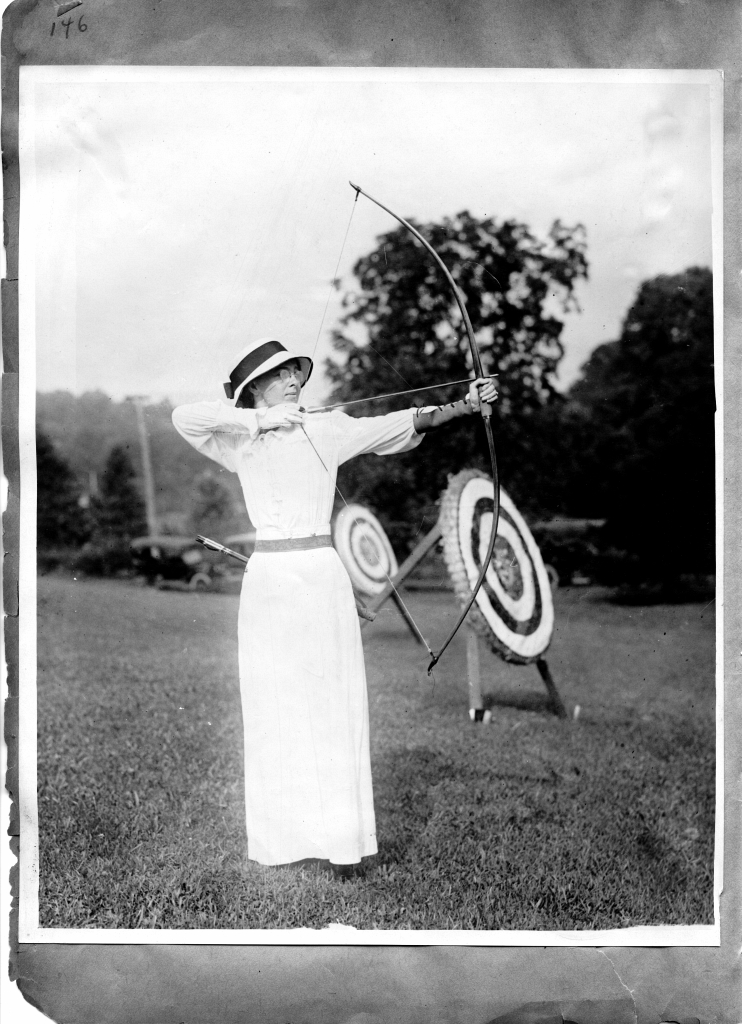
A woman shooting next to a coiled straw archery target with a cloth target face. It might seem like she is shooting the wrong way but historically it was common to have archery targets on both ends of the field so everyone could shoot one way, then walk to the other side to collect their arrows and shoot back the other way. From the National Archery Association’s Scrapbook, c. 1912.
Coiled straw matts are still used by competitive archers in some areas, inducing France, and by historical recreationists.
The straw matts are made by tying straw into long, tightly compacted bundles about 4 inches thick, and sewing them into spiral coils. The authors of The Flat Bow, 1936, give instructions:
Having finished all his equipment, the archer will want
something to shoot at. Regular straw targets may be purchased from dealers in archery equipment. They are made of rye or wheat straws about 4 in. thick and 4 ft. in diameter. They can be made at home if one has the necessary rye or wheat straw, marsh hay, or dried bullrushes. Such a straw target is made in much the same manner as that followed in making a grass table mat. The coils are made 4 in. thick, and they must be wrapped as tightly as possible with heavy cord.
Keep adding material as you go along to keep the coil uniform, and until the length is sufficient to make the 4-ft. circle. This may mean 40 or more feet of 4-in. coil. Then roll it into a tight spiral, using a heavy upholsterer’s needle to sew the adjacent coils together as the spiral is formed. Then cover the whole target with burlap sewed around the edge.
Making your own coiled straw matt is a lot of very hard manual labor, and historical archery manuals often suggest that even if archers like making their archery gear, straw matts are something archers were better off buying from a manufacturer. In the 1800’s the matts were made by hand. Today, the matts are made with the aid of machines, such as these used at Lyon Archerie / Viking Ciblerie.
Note the round straw bale feeding the machinery in the photo at the right, and the wound, continuous bundle of straw feeding the target coiling machine in the photo on the left.
Before the portable straw matts were invented, large mounds of dirt, called butts, were often used. One common type was around 7 high, flat in front, and sloped like a wedge in back.
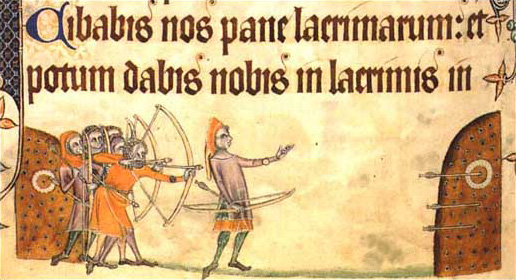
Archery practice at earthen butts, c1325. The center markers are small wreaths. Detail from the Geoffrey Luttrell psalter.
Butts like these were common in England in the 1300-1400s when common folk were required to practice at archery to insure that there were plenty of trained longbowmen to be soldiers. The earthen butts began to fall out of favor in the early 1800s, according to The Archer’s Guide, 1833.
Now what about the target face with the concentric rings? We don’t know when they were invented. Historically, archers shot at a mark on the butt and were scored in various ways, such as on whether you hit the butt, the mark or by seeing who’s arrows came closest to the mark.
Targets with concentric rings may date back to 1400s. We know they existed in the mid 1700s, and that by 1781 some archery contests were scored based on numeric values assigned to each ring, but were also judged on the number of hits to the target overall rather than the rings, a practice which continued through the 1800’s. Even today, many archery contests still record the total number of hits in addition to the ring-based numerical score.
Archery target faces were not standardized. There were no national standards. People and groups made up their own targets by their own designs. In the late 1700’s and early 1800’s one high society archery club, the Toxophilites, influenced what would later become the iconic archery target that we all recognize today, by setting standard distances and scoring (9,7,5,3,1 from the gold spot out) on a target design then in use. The target face they adopted had a gold leaf or metallic gold paint center spot, a red ring, a white ring, a black ring, and another white ring. A green outer border was common. Sometimes a light blue was used in place of the inner white to avoid confusion when writing down scores. The version with the light blue ring became the target we now used to day, though the the metallic gold paint center spot that was used up through the 1940’s is now simply yellow and there are now 10 rings instead of just the five formed by the colors. For their “Imperial” rounds the UK still uses 9,7,5,3,1 scoring and just the 5 colored rings. The French still call the 5 color target the “English target.”
References
For information on the history of Target Archery, check E. G. Heath’s “A History of Target Archery,” 1973. For more on the kinds of targets shot in medieval times, historical recreationist “Sir Jon Fitz-Rauf” has an essay, “European Medieval and Renaissance Archery Contests And Targets” that provides a good overview of the widely varied targets they used, and on how little we actually know about them today. See also, The Archer’s Guide, 1833, for a how to on archery from 1833.
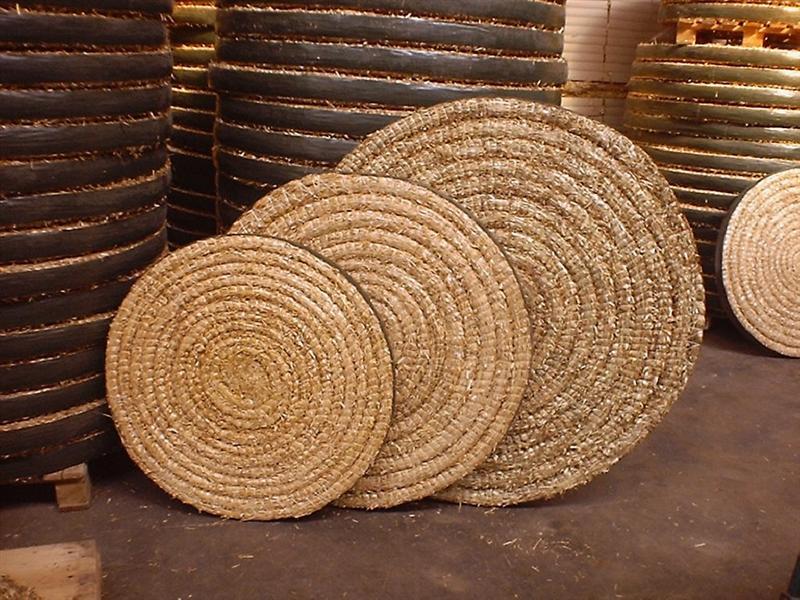
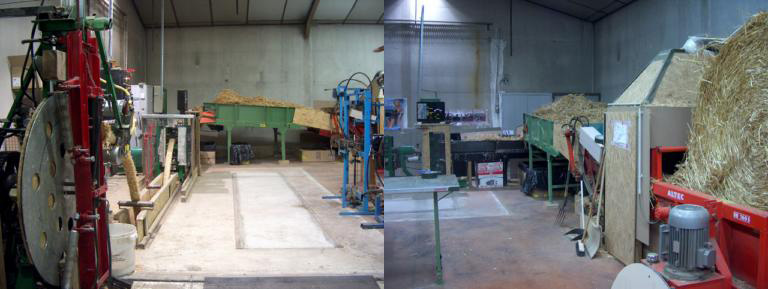
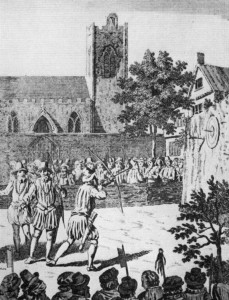
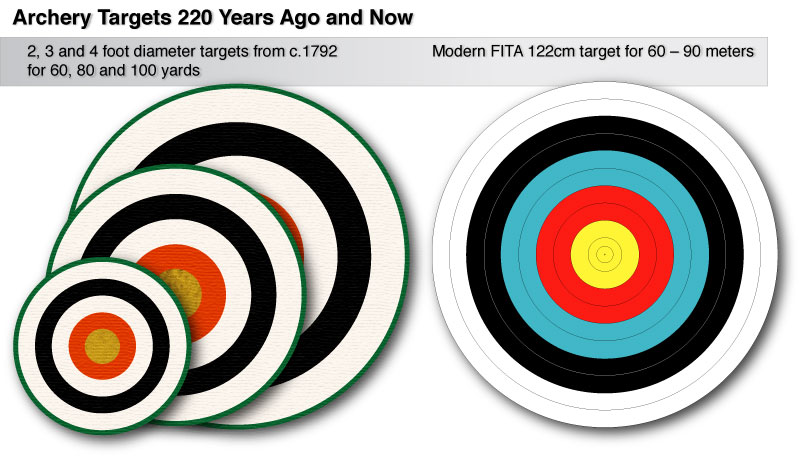
Gerard
What was your source for concentric circle targets perhaps dating back to the 1400’s? I would like to add this information to my files.
Good article.
Thank you
John Edgerton. Newark, CA
“What was your source”
Thanks for the inquiry. The post was made in a quick whirlwind of
research and I’ve lost my short term memory of the citation 1400s claim
:-0. My mind is now a jumble of primary and secondary texts, and my note
taking was decidedly not up to academic standards for the blog post,
though I endeavored to be accurate. I’ll see if I can find the source
again. Until then consider it “Citation Needed”.
I find the history of archery targets interesting and your article was a
great find. It is kind of ironic that it is so much easier to find the
history of targets in the 1700 and 1800s than it is to find the history
of many of the targets in the 1900s. Overly long copyright laws mean
that scans of documents from the 1800’s may be freely posted, but those
from the 1900s less so. I’ve not been able to find when the 10 ring FITA
target was invented, even though it had to have been created in the
1930’s or later–but FITA doesn’t care much about its own history, only
its present, and even then they are mostly about promoting the Olympic
Games, which is where most of their money comes from.
BTW, do you have any history on what the French Beursault was
historically? Now they use a multizone target (that they refuse to call a
target for some reason). They make great claims about how long the
history of Beursault goes back, but I haven’t found when the current
styles of target entered into that tradition. I’d never even heard of
Beursault until reading your article–let alone that it is still shot
today in France.
Yes, Beursault is shot regularly in France as the traditional form of french archery, whose motto is Honor and Courtesy. Beursault comes with a whole set of distinctive vocabulary and code of conduct. The target face is known as “carte” (and made of cardboard) as opposed to the paper “blason” that refers to the FITA face. For traditional tournaments known as Prix Généraux, in the middle of the carte stands the “marmot” which is removable piece representing the center part. Whenever an arrow hits the central black spot (two inches in diameter), the marmot is removed together with the arrow and presented to the archer. After having removed carefully his arrow (not to enlarge the hole), he signs at the back and the marmot is kept until the end of the tournament with the distance to the center precisely measured (in 1/20 mm). The prizes are given in money, as a percentage of the total fees collected. A famous Prix Général is held once a year in May and is known as Bouquet Provincial. It is commonly hosted in northern France and about 300 clubs attend the event and participate to the tournament that follows and goes on til September.
Besides, Beursault is also practiced as a more classical tournament with a national championship. This is where the carte has multiple scoring zones from 1 to 4. Beursault has a very specific scoring. First counts the number of arrows in the target (honours), maximum being 40. Then, the number of points is used to distinguish between the same number of honours and finally the number of chaplets (the inner circle) would be used to distinguish the same number of honours and the same number of points.
Henry-Charles Arnauld de Pomponne standardized the code of practice for all archery companies in the kingdom of France in 1733 and this is the common reference for Beursault. However, he simply unified and harmonized what was already there and there are traces of such statutes dating 1411 in Montpellier, themselves referring to older sources, probably established during the reign of Charles V in late 14th century.
Beursault is so very French–almost more of a fraternal and chivalric tradition than archery–and a great and rare connection with the past. That the French still shoot this tradition which shoots a single arrow, then moves 50 yards to the other end of archery range toshoot back in the other direction repeating 40 times, is not surprising. Outside of that historical and social tradition such a slow competition does not seem likely to appeal.
Do you have any information on how long the cards with concentric rings have been used in Beursault? I was unable to find this information on-line.